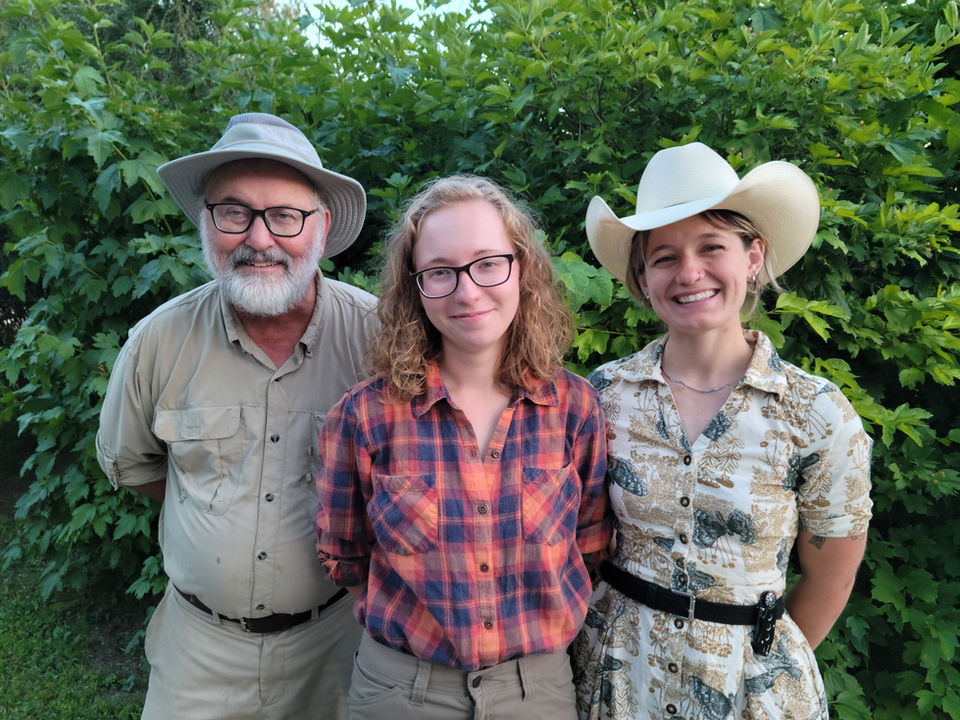About the Cliff Swallow Project
The Cliff Swallow Project has its roots in a study conducted in the early 1970's on bank swallows in Michigan. Biologists John Hoogland and Paul Sherman measured the costs and benefits of living in colonies, using natural variation in the bank swallows' colony sizes. They studied, for example, how bigger colonies might offer advantages to bank swallows by helping the birds detect and avoid predators more successfully. However, they also found that there were disadvantages of large colonies because more fleas infested the birds' nests there. Charles Brown decided to ask similar questions for cliff swallows, which was the initial impetus for the project. When he became Hoogland's graduate student in 1981, the project was conceived as Brown's Ph.D. research. Charles made the decision to study cliff swallows in about five minutes.
Brown was fortunate to locate the Cedar Point Biological Station in western Nebraska as his study site, where field work commenced in 1982. The area around Cedar Point has probably the highest density of cliff swallow colonies of any region in North America, and colony sizes there vary widely. Some colonies can reach 6000 nests in size, while others can be as small as 2 nests, and a few birds nest as single pairs. This natural variation in colony size has contributed heavily to the longevity of the project, because it has allowed us to address many fundamental questions about the evolution of social behavior in animals.

Our research has sought generally to understand the selective pressures that bring about social living in cliff swallows, how the birds' fitness changes in different sized groups, and what ecological conditions lead to variation in group size.
The main areas of investigation have been:
Researchers

Charles R. Brown, Ph.D
Charles began studying cliff swallows in 1980, and has conducted research on them full-time since 1982. His cliff swallow research in western Nebraska is one of the longest-running field studies of birds done in North America. He received a B.A. in biology from Austin College in 1981, and a Ph.D. in biology from Princeton University in 1985. He is currently a professor of biological science at the University of Tulsa, where he has been since 1994. Charles’ research on cliff swallows was recognized by the Elliot Coues Award from the American Ornithologists’ Union in 2009 for extraordinary contributions to ornithological research, and by the Exemplar Award from the Animal Behavior Society in 2011 for major long-term contributions to the study of animal behavior. His book, Swallow Summer (University of Nebraska Press, 1998), was described by Booklist as one of the best popularizations about field research ever written. For more, see Charles' Career Inspiration Story from the Perot Museum of Nature and Science.

Mary Bomberger Brown
Mary began studying Cliff Swallows in 1982 and worked on the project full-time through 2006. Her other research interests included habitat selection in Wilson’s phalaropes and conservation and management of interior least terns, piping plovers, and greater prairie-chickens. She received a Ph.D. from the University of Nebraska in 2011 and was an associate professor at the University of Nebraska-Lincoln at the time of her death in 2019. For her work on cliff swallows, she was co-recipient of the Elliot Coues Award from the American Ornithologists’ Union in 2009 for extraordinary contributions to ornithological research.

Gigi Wagnon

Amy Moore

Catherine Page
Stephanie Strickler
Christine Sas
Bruce Rannala
Erin Roche

Stacey Hannebaum
Abinsah Padhi
Jerome Foster
Samrrah Raouf
Linda Smith- Laura Molles(Yale University)Laura Monti(Yale University)Shyam Narotam(University of Tulsa)Cecily Natunewicz(Yale University)Cheryl Ormston(University of Tulsa)Charlene Patenaude(University of Dallas)Sunita Quick(Colorado College)Barbara Raulston(University of Texas atGabriela Redwine(Yale University)Craig Richman(University of Pennsylvania)Page 1 of 8



































